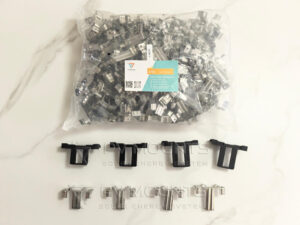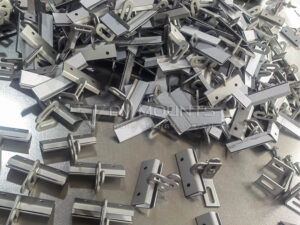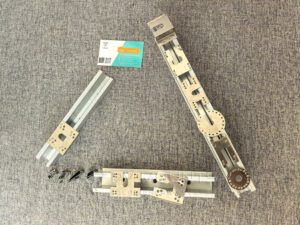Sistemele de montaj solar sunt esențiale pentru captarea eficientă a energiei solare. Acoperișurile cu îmbinare permanentă sunt ideale pentru aceste instalații, oferind un amestec perfect de formă și funcționalitate. Sistemele de montaj solar sunt minuni de inginerie care valorifică energia soarelui cu precizie și fiabilitate. Opțiunile disponibile sunt inovatoare și variate, inclusiv modele bazate pe cleme și fără șine, fiecare oferind o estetică raționalizată.
În cadrul acestei explorări, vom călători pe tărâmurile tehnologiei solare, descoperind complexitatea sistemelor de montare și relația simbiotică dintre acestea și acoperișurile cu cusături verticale. Narațiunea nu este doar tehnică, ci și o poveste a progresului, evidențiind modul în care aceste sisteme au evoluat pentru a satisface atât cerințele mediului, cât și pe cele ale consumatorilor preocupați de energie.
Tabla de conținut
Avantajele montajului solar cu cusătură permanentă
Acoperișurile cu cusături permanente, cunoscute pentru durabilitatea și aspectul lor elegant, oferă mai mult decât un simplu aspect estetic; ele sunt o fortăreață pentru instalațiile solare. Aceste acoperișuri se caracterizează prin cusăturile lor ridicate, care se întind vertical de-a lungul acoperișului, creând o serie de creste și văi. Acest design unic nu numai că contribuie la farmecul lor vizual izbitor, dar sporește și integritatea lor structurală, făcându-le o gazdă ideală pentru panourile solare.
Unul dintre avantajele deosebite ale acoperișurilor cu cusături permanente este longevitatea lor. Aceste acoperișuri metalice pot rezista la condițiile meteorologice nefavorabile, oferind o bază solidă pentru panourile solare pentru decenii de acum înainte. În plus, designul lor minimizează nevoia de metode de instalare penetrante, care pot compromite integritatea acoperișului și pot duce la pătrunderea apei.
Un alt avantaj semnificativ este ușurința instalării. Sistemele de montare a instalațiilor solare pe acoperișurile cu cusături verticale pot fi adesea atașate direct la cusături, eliminând necesitatea de a face găuri. Acest lucru nu numai că accelerează procesul de instalare, dar reduce și riscul de scurgeri, asigurând că acoperișul rămâne intact și rezistent la intemperii.
Pe scurt, acoperișurile cu îmbinare în picioare oferă o combinație optimă de durabilitate, ușurință de instalare și întreținere minimă, ceea ce le face o alegere excelentă pentru instalarea panourilor solare. Ele reprezintă un amestec armonios de formă și funcție, oferind o soluție fiabilă și estetică pentru cei care doresc să adopte energia solară.
Tipuri de sisteme de montaj solar pentru acoperișuri cu șarpantă
Lumea sistemelor de montare a instalațiilor solare este diversă, fiecare tip fiind adaptat pentru a se potrivi contururilor unice ale acoperișurilor cu cusături verticale. În prima linie se află sistemele bazate pe cleme, renumite pentru metoda lor de instalare neintruzivă. Aceste sisteme utilizează cleme speciale care se fixează direct pe cusăturile acoperișului, fixând panourile solare în poziție fără a fi nevoie de găurire, păstrând astfel integritatea și garanția acoperișului.
Sistemele fără șine reprezintă următoarea evoluție în tehnologia de montare a sistemelor solare. Prin eliminarea nevoii de șine metalice tradiționale, aceste sisteme oferă un aspect mai elegant, mai integrat, care completează estetica modernă a acoperișurilor cu cusături verticale. Panourile solare sunt montate direct pe clemele fixate pe cusături, reducând utilizarea materialelor și simplificând procesul de instalare.
Sistemele integrate duc această integrare un pas mai departe, îmbinând panourile solare și suprafața acoperișului într-o unitate fără sudură. Aceste sisteme implică adesea panouri solare special concepute care se dublează ca panouri de acoperiș, nu doar generând electricitate, ci și făcând parte din acoperișul însuși. Această integrare atinge un nivel de armonie estetică și eficiență pe care sistemele tradiționale nu reușesc să îl egaleze.
Fiecare tip de sistem de montaj solar oferă propriul set de beneficii, de la instalarea simplă a sistemelor bazate pe cleme la integrarea estetică și funcțională a sistemelor integrate. Alegerea depinde de nevoile și preferințele specifice ale proprietarului, fiecare sistem oferind o soluție robustă, eficientă și plăcută din punct de vedere estetic pentru valorificarea energiei solare pe acoperișurile cu cusături verticale.
Considerații tehnice pentru instalare
Instalarea sistemelor de montaj solar pe acoperișuri cu cusături verticale necesită o analiză tehnică meticuloasă. Procesul începe cu o evaluare cuprinzătoare a acoperișului, asigurând compatibilitatea acestuia cu instalațiile solare. Factorii precum vechimea acoperișului, materialul și integritatea structurală sunt analizați pentru a garanta că fundația poate susține greutatea instalației solare și poate rezista presiunilor mediului.
Orientarea panourilor solare este esențială pentru o producție maximă de energie. În mod ideal, panourile ar trebui să fie orientate spre sud în emisfera nordică. Unghiul de înclinare, adaptat la locația geografică, sporește capacitatea panourilor de a absorbi eficient energia solară. În plus, factorii de mediu, cum ar fi umbrirea, sarcina vântului și sarcina zăpezii, trebuie evaluați pentru a asigura reziliența sistemului și longevitatea performanței.
Parcurgerea acestor aspecte tehnice necesită nu numai expertiză tehnică, ci și o înțelegere profundă a tiparelor climatice locale și a codurilor de construcție. Această abordare meticuloasă asigură că sistemul de montaj solar nu este doar solid din punct de vedere tehnic, ci și optimizat pentru producția de energie pe termen lung.
Procesul de instalare a sistemelor de montaj solar
Instalarea sistemelor de montare a instalațiilor solare pe acoperișuri cu cusături verticale este o simfonie a preciziei și a planificării. Procesul se desfășoară într-o serie de etape bine orchestrate, începând cu fixarea sigură a clemelor sau a suporturilor la îmbinările acoperișului. Aceste fixări servesc drept fundație pe care se vor sprijini panourile solare.
După faza de fixare, panourile solare sunt montate metodic pe schelet, asigurându-se că fiecare panou este bine fixat și conectat electric. Procesul de cablare este executat cu o atenție deosebită pentru siguranță și funcționalitate, integrând panoul solar în sistemul electric al proprietății. Această integrare este completată de instalarea invertoarelor, care convertesc curentul continuu (DC) generat de panouri în curent alternativ (AC), adecvat pentru uz casnic sau profesional.
Pe parcursul procesului de instalare, utilizarea de unelte și echipamente specializate este esențială pentru realizarea unei instalări eficiente și fără probleme. Aceste instrumente facilitează alinierea precisă și fixarea sigură a panourilor solare, asigurând performanța optimă și durabilitatea acestora. Întregul proces, ghidat de mâinile unor tehnicieni calificați, culminează cu un sistem de energie solară complet funcțional, care reprezintă o dovadă a sinergiei dintre tehnologie și durabilitate.
Întreținerea și îngrijirea sistemelor solare
După instalare, întreținerea și îngrijirea sistemelor solare devin esențiale pentru menținerea eficienței și longevității acestora. Verificările de rutină sunt esențiale pentru identificarea și remedierea oricăror probleme potențiale, cum ar fi conexiunile slăbite, acumularea de resturi sau uzura. Curățarea periodică a panourilor solare este, de asemenea, esențială pentru menținerea eficienței de absorbție a energiei, deoarece praful, frunzele și alte obstacole pot reduce semnificativ performanța acestora.
Abordarea promptă a problemelor comune, cum ar fi funcționarea defectuoasă a invertorului sau impactul umbririi, asigură funcționarea sistemului la capacitate maximă. Tehnicienii echipați cu instrumente de diagnosticare și expertiză pot rezolva rapid astfel de probleme, minimizând timpii morți și pierderile de energie.
Regimul de întreținere a sistemelor solare pe acoperișuri cu cusături verticale pune accentul pe măsurile preventive, cu scopul de a evita problemele înainte ca acestea să se agraveze. Această abordare proactivă nu numai că prelungește durata de viață a sistemului, ci și maximizează producția sa de energie, asigurând o soluție fiabilă și eficientă de energie solară pentru anii următori.
Analiza costurilor și ROI pentru sistemele solare de pe acoperișurile cu șarpantă
Peisajul financiar al instalării sistemelor solare pe acoperișuri cu îmbinare în picioare cuprinde o investiție inițială care se transformă în economii pe termen lung și un randament substanțial al investiției (ROI). Costurile inițiale, deși semnificative, sunt atenuate de multitudinea de stimulente financiare disponibile, cum ar fi creditele fiscale, reducerile și subvențiile. Aceste stimulente, menite să promoveze adoptarea energiei regenerabile, pot reduce substanțial costul net al instalațiilor solare.
Analiza rentabilității investiției implică compararea costurilor inițiale de instalare cu economiile continue rezultate din reducerea facturilor la utilități. De obicei, sistemele solare se amortizează în timp prin aceste economii, perioadele de amortizare variind în funcție de factori precum prețurile locale la energie și nivelurile de insolație. În plus, instalațiile solare pot crește valoarea proprietății, oferind un beneficiu financiar indirect proprietarilor.
Dincolo de considerentele financiare imediate, perspectiva pe termen lung relevă un scenariu în care energia solară reduce semnificativ costurile energiei electrice, în special pe măsură ce prețurile energiei tradiționale continuă să crească. Acest avantaj economic, coroborat cu beneficiile de mediu ale energiei regenerabile, poziționează sistemele solare pe acoperișuri cu cusături permanente ca o investiție înțeleaptă atât din punct de vedere financiar, cât și ecologic.
Tendințe viitoare în tehnologia acoperișurilor solare
Orizontul tehnologiei acoperișurilor solare este marcat de tendințe inovatoare și progrese care promit să îmbunătățească eficiența, estetica și integrarea sistemelor solare pe acoperișurile cu cusături verticale. Inovațiile tehnologice, cum ar fi panourile solare bifaciale, care captează lumina soarelui pe ambele părți, și tehnologiile solare cu film subțire, cunoscute pentru flexibilitatea și designul lor ușor, sunt menite să redefinească eficiența și aplicarea soluțiilor de acoperișuri solare.
În plus, integrarea tehnologiei inteligente și a sistemelor solare este în creștere, progresele în materie de software și instrumente de monitorizare permițând gestionarea energiei în timp real și optimizarea performanței. Aceste instrumente nu numai că îmbunătățesc funcționalitatea sistemelor solare, dar îmbunătățesc și experiența utilizatorului, oferind informații detaliate privind producția de energie și modelele de consum.
Viitorul oferă, de asemenea, potențial pentru o integrare mai perfectă a panourilor solare în materialele pentru acoperișuri, ceea ce va conduce la dezvoltarea de țigle și șindrile solare care se integrează fără efort în estetica acoperișurilor cu cusături verticale. Această evoluție către soluții solare mai integrate și mai puțin deranjante semnifică o evoluție către clădiri complet durabile, în care energia solară joacă un rol central în proiectarea arhitecturală și în strategia energetică.
Impactul energiei solare asupra durabilității
Adoptarea energiei solare pe acoperișurile cu pereți verticali joacă un rol esențial în mișcarea globală către durabilitate. Prin valorificarea energiei solare regenerabile, aceste sisteme contribuie semnificativ la reducerea amprentei de carbon și la atenuarea impactului schimbărilor climatice. Energia verde și curată produsă de panourile solare înlocuiește în mod direct nevoia de energie electrică generată din combustibili fosili, ducând la o scădere substanțială a emisiilor de gaze cu efect de seră.
Dincolo de beneficiile de mediu, impactul sistemelor solare asupra durabilității se extinde la avantajele socio-economice. Creșterea adoptării energiei solare favorizează crearea de locuri de muncă în sectorul energiei regenerabile, promovând dezvoltarea economică și, în același timp, obiectivele de mediu. În plus, trecerea la surse de energie durabile, precum energia solară, sporește securitatea și independența energetică, reducând dependența de combustibilii importați și consolidând reziliența energetică națională.
Concluzie: Viitorul luminos al energiei solare pe acoperișurile cu îmbinare permanentă
Integrarea sistemelor de montaj solar pe acoperișurile cu îmbinare în picioare reprezintă un pas transformator în căutarea soluțiilor energetice durabile. Această combinație nu numai că valorifică avantajele structurale ale acoperișurilor cu cusături verticale, dar se aliniază și obiectivelor globale de durabilitate, oferind o soluție energetică fiabilă, eficientă și ecologică. Pe măsură ce tehnologia avansează și angajamentul societății față de energia ecologică se consolidează, viitorul energiei solare pe acoperișuri cu îmbinare în picioare strălucește, promițând o moștenire de gestionare a mediului și inovare regenerabilă.
Întrebări frecvente
Cum funcționează sistemul de montaj solar cu acoperișurile cu cusături verticale?
Sistemele de montare a panourilor solare pe acoperișuri cu cusături permanente utilizează cleme sau suporturi special concepute care se fixează în siguranță pe cusăturile acoperișului fără a penetra suprafața. Această metodă menține integritatea acoperișului și asigură o fundație stabilă pentru panourile solare.
Care sunt avantajele utilizării acoperișurilor cu cusături permanente pentru instalarea panourilor solare?
Acoperișurile cu îmbinare permanentă oferă durabilitate, ușurință de instalare și întreținere minimă pentru sistemele solare. Designul lor permite o fixare nepenetrantă a panourilor solare, reducând riscul de scurgeri și asigurând integritatea acoperișului pe termen lung.
Sistemele de montaj solar pot fi instalate pe orice acoperiș cu îmbinare permanentă?
În timp ce majoritatea acoperișurilor cu cusături verticale sunt potrivite pentru sistemele de montare a energiei solare, o evaluare detaliată a stării, materialului și structurii acoperișului este esențială pentru a asigura compatibilitatea și instalarea optimă.
Care este durata de viață a unui sistem de montaj solar pe un acoperiș cu cusături verticale?
Sistemele de montare a instalațiilor solare pe acoperișuri cu cusături verticale pot dura 25 de ani sau mai mult, reflectând durata de viață a panourilor solare. Durabilitatea acestora este sporită de robustețea acoperișurilor cu cusături verticale și de metoda de instalare neinvazivă.
Cum afectează vremea performanța panourilor solare de pe acoperișurile cu cusături verticale?
Panourile solare sunt concepute pentru a rezista la diferite condiții meteorologice, însă condițiile meteorologice extreme le pot afecta performanța. Instalarea și orientarea corectă a panourilor pot minimiza aceste efecte, asigurând o producție constantă de energie.
Care sunt cerințele de întreținere pentru sistemele de montare a energiei solare pe acoperișuri cu cusături permanente?
Întreținerea este în general redusă, implicând curățarea periodică a panourilor și inspecții de rutină pentru a verifica eventualele probleme. Acest lucru asigură funcționarea eficientă a sistemului de-a lungul timpului.


-1.jpg)










